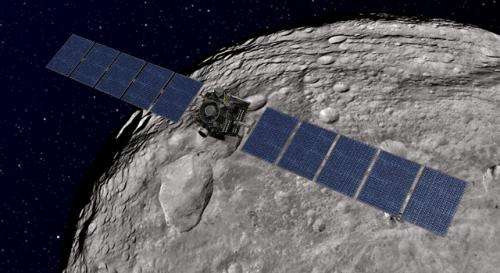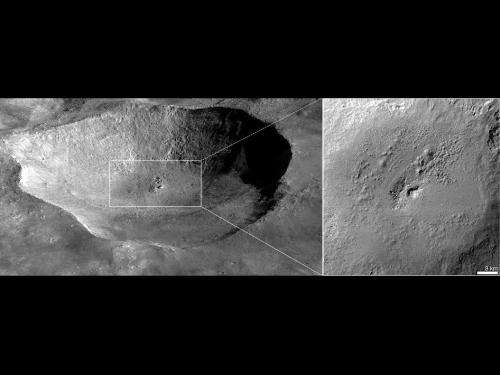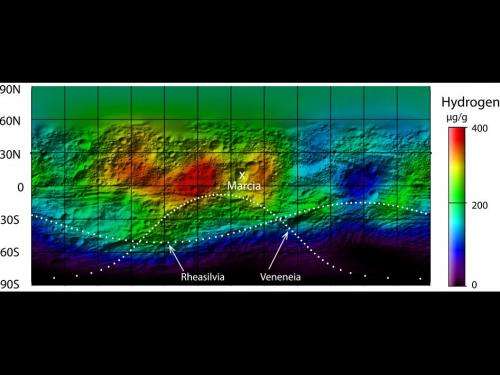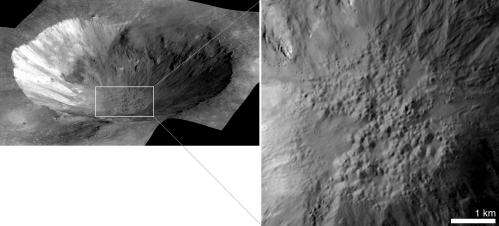This artist's concept shows NASA's Dawn spacecraft orbiting the giant asteroid Vesta. The depiction of Vesta is based on images obtained by Dawn's framing cameras. Image credit: NASA/JPL-Caltech
(Phys.org)—The first measurements of the elemental composition of the surface of the giant asteroid Vesta indicate that hydrogen was brought to the body by impactors, research by a team led by Planetary Science Institute Senior Scientist Thomas H. Prettyman has shown.
Using data collected by the NASA Dawn mission's spacecraft's gamma ray and neutron detector instrument—GRaND—as it circled the giant asteroid, researchers also confirmed the elemental composition of the surface of Vesta matches meteorites found on Earth believed to have originated from Vesta.
The hydrogen content of Vesta's regolith, or rocky surface materials, is consistent with delivery of hydrogen-bearing, carbonaceous chondrite materials to Vesta, Prettyman and co-authors report in a paper titled "Elemental Mapping by Dawn Reveals Exogenic H in Vesta's Regolith" that appears in Science.
This perspective view of Marcia crater on the giant asteroid Vesta shows the most spectacularly preserved example of "pitted terrain," an unexpected discovery in data returned by NASA's Dawn mission. Image credit: NASA/JPL-Caltech/UCLA/MPS/DLR/IDA/JHUAPL
The highest concentrations of hydrogen were found in equatorial regions, where water ice is not stable. The lowest amounts were found within the giant, south-polar Rheasilvia impact basin. The amounts of hydrogen and its association globally with broad, low albedo—low reflective—regions on Vesta indicate the infall of carbonaceous chondrites bearing hydrated minerals as the likely origin. A companion paper by Brett Denevi of Johns Hopkins University Applied Physics Laboratory shows pitted regions within young craters that formed due to high velocity impacts into volatile-rich material.
The animation from NASA's Dawn mission shows abundances of hydrogen in a wide swath around the equator of the giant asteroid Vesta. Credit: NASA
"Where did the hydrogen from Vesta's surface come from? We ruled out the wind of charged hydrogen particles streaming off the Sun as a source, as well as water ice within the top few feet of Vesta's surface," Prettyman said. "The hydrated minerals appear to be delivered by carbon-rich space rocks that collided with Vesta at speeds slow enough to preserve their volatile content."
This map from NASA's Dawn mission shows the global distribution of hydrogen on the surface of the giant asteroid Vesta. Credit: NASA/JPL-Caltech/UCLA/PSI/MPS/DLR/IDA
GRaND's first elemental measurements of Vesta's surface showed the composition matches howardite, eucrite and diogenite (HED) meteorites believed to have been blasted off of Vesta, Prettyman said.
"The Vesta-HED connection was established long ago by comparing the spectrum of reflected light for the HED meteorites with telescopic measurements of Vesta," he said. "GRaND confirms this by showing that the abundances of iron and silicon are consistent with HEDs.
Dawn orbited within 210 kilometers of Vesta, allowing GRaND a unique opportunity to analyze the asteroid. "From a broader perspective, we are reporting the first direct measurements of Vesta's elemental composition, which can only be accomplished by getting very close to Vesta," Prettyman said. "It is unlikely these measurements will be repeated any time soon."
This perspective view of Cornelia crater on the giant asteroid Vesta shows an example of "pitted terrain," an unexpected discovery in data returned by NASA's Dawn mission. Image credit: NASA/JPL-Caltech/UCLA/MPS/DLR/IDA/JHUAPL
Dawn left Vesta's orbit Sept. 4 and is making its way to a rendezvous with the dwarf planet Ceres in early 2015.
The data acquired by GRaND are available to the public through the NASA Planetary Data System.
More information: www.sciencemag.org/content/ear … 9/19/science.1225354
Journal information: Science
Provided by Planetary Science Institute


























